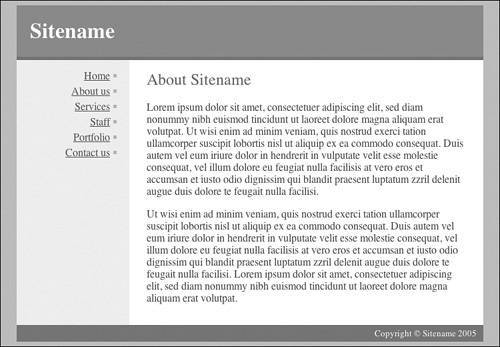Styling the a Element
Styling the <a> ElementThe final step in this lesson involves setting the link colors. You will work on four pseudo-classes. The a:link pseudo-class can be set to color: #175B7D, and the a:visited pseudo-class can be set to color: #600. The a:hover and a:active pseudo-classes also can be set with color: #fff; and background: #175B7D as shown in Listing 19.12. The results can be seen in Figure 19.11. Listing 19.12. CSS Code for Styling the <h2> Elementbody { text-align: center; background: #B0BFC2; color: #444; } #container { text-align: left; margin: 0 auto; width: 700px; background: #FFF url(header-base.gif) repeat-y; } h1 { background: #D36832; color: #FFF; padding: 20px; margin: 0; border-bottom: 5px solid #387A9B; } #nav { float: left; width: 130px; display: inline; margin-left: 20px; padding: 15px 0; } #nav ul { margin: 0; padding: 0; list-style-type: none; text-align: right; } #nav li { background: url(header-bullet.gif) no-repeat 100% .4em; padding: 0 10px 5px 0; } #content { float: left; width: 475px; margin-left: 45px; padding: 15px 0; } #footer { clear: both; background: #387A9B; color: #fff; padding: 5px 10px; text-align: right; font-size: 80%; } h2 { margin-top: 0; color: #B23B00; font-weight: normal; } a:link { color: #175B7D; } a:visited { color: #600; } a:hover, a:active { color: #fff; background: #175B7D; } Figure 19.11. Screenshot of styled <a> element. |
Sams Teach Yourself CSS in 10 Minutes
ISBN: 0672327457
EAN: 2147483647
EAN: 2147483647
Year: 2005
Pages: 234
Pages: 234
Authors: Russ Weakley